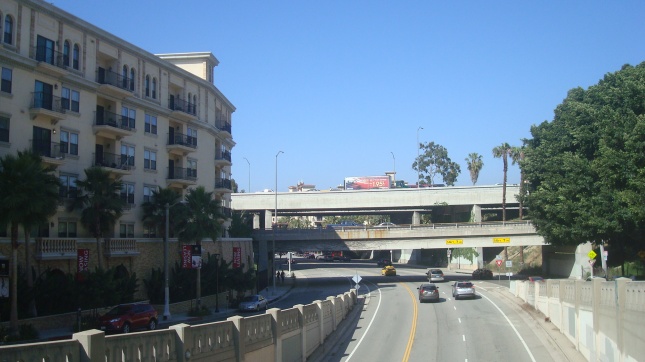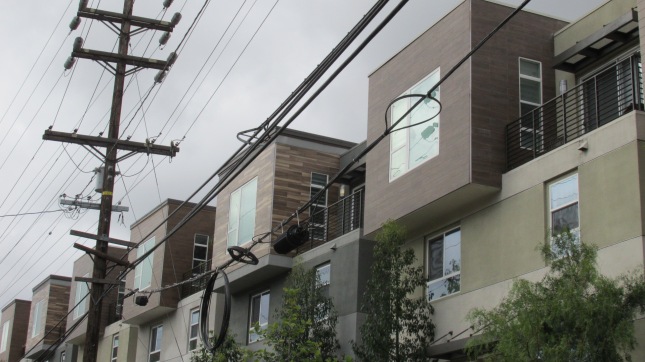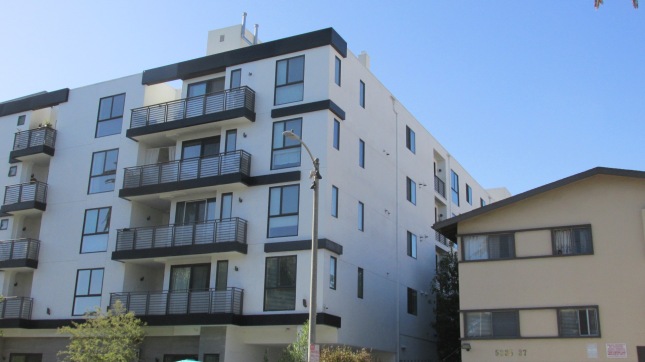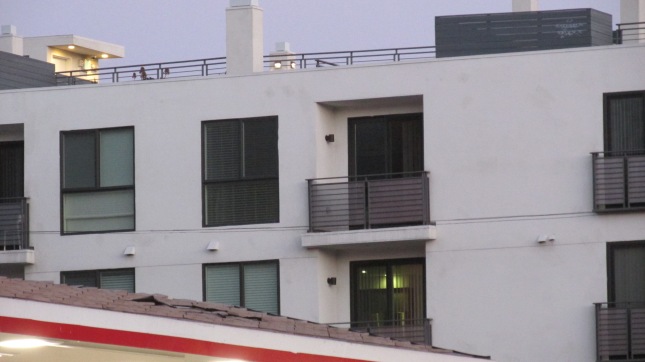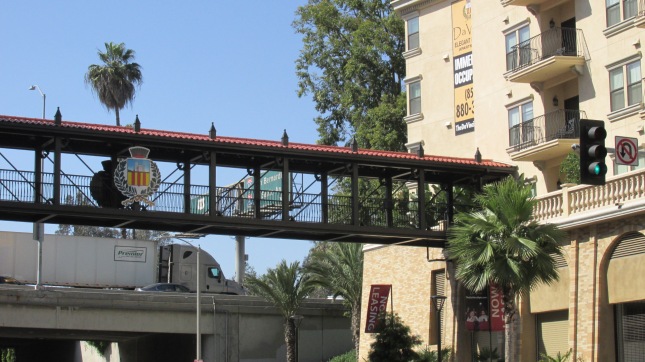
The speculative real estate binge that’s sweeping across LA right now has drawn a swarm of unscrupulous people willing to do whatever it takes to make a profit. In talking to community members over the past few years I’ve heard some hair-raising stories, but nothing that tops the reports I’ve heard from the tenants of the Sachs Apartments in Silverlake.
To give you some background, the Sachs Apartments (also known as Manola Court) were created by architect Rudolph Schindler for interior designer Herman Sachs. They’re a stunning example of Schindler’s work, a collection of buildings that step gracefully down a hillside, connected by steep stairways and terraced paths. The City of LA has recognized the importance of the site, naming it a Historic-Cultural Monument (HCM) in 2016.

A view of the Sachs Apartments from Edgecliffe.

Another view from Edgecliffe.

A gate leading to a walkway between two buildings.
The Sachs Apartments were purchased by the current owners some years back. While there are three names listed on documents filed with the City, the person who has been dealing with the tenants and supervising the “restoration” is Paul Finegold. I’ve been hearing a lot about Mr. Finegold lately, and most of the comments have been pretty negative.
To start with, a number of tenants claim that Finegold has been harrassing them, and they believe he’s doing his best to get rid of them. There have been reports that he doesn’t maintain the units properly, and is slow to act when problems come up. I wanted to learn more, so last Thursday I showed up for a meeting of the Urban Design & Preservation Advisory Committee of the local neighborhood council. The only item on the agenda was the situation at the Sachs Apartments, and there was plenty to talk about. A number of tenants attended. They talked about water leaking through the ceiling, workers leaving debris on the site, and respiratory issues that may be related to dust from construction. Apparently Finegold has posted at least one unit on AirBnB, and the tenants said the guests are often out of control. One woman said she found a couple having sex right in front of her apartment.
And there’s more. According to the people at the meeting, three tenants have already been evicted by Finegold, who claimed that he, his mother, and a resident manager were moving in. But according to the current tenants, neither Finegold nor his mother nor the manager are living on the site.
Beyond all that, a lot of people are asking whether Finegold is restoring the Sachs Apartments or wrecking them. Remember, this is a Historic-Cultural Monument designed by someone who played a key role in LA’s architectural history. Having pledged to do a careful restoration of the site, Finegold is receiving substantial tax breaks under the Mills Act. But tenants say he’s made significant alterations, reconfiguring the interiors of some units and removing the bathroom from one. They also claim workers have cut down 4 mature trees and removed tiles designed by the original owner, Herman Sachs. Former tenant Judith Sheine, an authority on Schindler’s work, has expressed her concern that Finegold’s crews are doing damage to the complex.
I decided to go to the LA Department of Building & Safety (LADBS) web site to check out some of the permits that Finegold has pulled. Here are some excerpts….
“REMOVE FULL BATH ON FIRST FLOOR AND CREATE A POWDER ROOM ELSEWHERE ALSO ON FIRST FLOOR. NO CHANGE TO PLOT PLAN.”
“CONVERT A 3 UNIT APARTMENT TO A 4 UNIT APARTMENT WITH INTERIOR ALTERATIONS.”
“ADD NEW BATH; REMOVE AND REPLACE SELECTED WINDOWS; NEW ROOFING; NEW COLOR COAT EXTERIOR PLASTER”
Is it really okay to do all this with a building that’s been designated as an HCM? Was LADBS aware that this is a historic building? Obviously, any structure that’s over 80 years old is going to need some work to comply with current codes, but removing a bathroom? Converting one structure from 3 to 4 units? Remember, Finegold is getting tax breaks under the Mills Act for the work he’s doing, and that means he’s required to follow the Secretary of the Interior’s Standards for Rehabilitation. Historic Resources Group, a widely respected consulting firm, helped Finegold file the Mills Act application. Do they know what’s going on at the Sachs Apartments?

A view of the Sachs Apartments from Lucile.

Far corner of the building on Lucile.
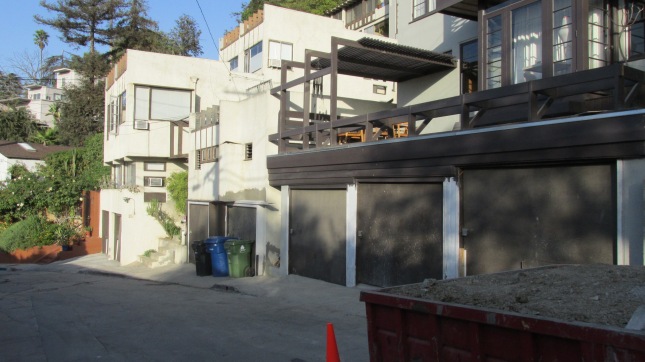
Another view of the building from Lucile.
And to top it all off, now Finegold has applied to convert 5 of the units to a bed and breakfast. That may seem like a small number, but remember, we’re in the middle of a housing crisis. And based on their experiences with Finegold, some of the tenants are worried that he eventually plans to convert the whole complex to a bed and breakfast.
So, will the Department of City Planning (DCP) reward this guy by allowing the change of use? Seems likely. In spite of the fact that City Hall keeps telling us that we don’t have nearly enough housing, the DCP has shown itself to be more than willing to work with owners who want to remove rental units from the market. The DCP has heard all about the tenants’ concerns, and so has Councilmember Mitch O’Farrell’s office. But so far nobody from the City seems willing to stand up and ask what the hell is going on at the Sachs Apartments.
If you think somebody from the City should be asking questions, maybe you could let them know you’re concerned. Send an e-mail to DCP staffer Azeen Khanmalek, and be sure to copy Councilmember Mitch O’Farrell.
How about this for a subject line?
Investigate Possible Damage to Historic Sachs Apartments
Azeen Khanmalek, Department of City Planning
Azeen.Khanmalek@lacity.org
Councilmember Mitch O’Farrell
councilmember.ofarrell@lacity.org


